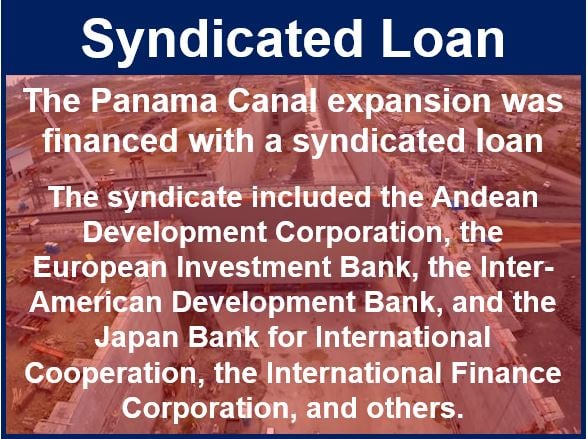What is a syndicated loan?
A syndicated loan, also known as a syndicated bank facility, is a loan where several financial institutions form a group (syndicate) and lend money to one borrower. There is just one loan agreement, with terms and conditions that apply to all the lenders in the syndicate.
The word ‘syndicate’ means a group of people or organizations combined to promote a common interest. This type of loan contrasts with a bilateral loan, which is a loan consisting of a single lender and a single borrower.
In a syndicated loan, the borrower might be a company, a large project or a country’s government (sovereignty).
A syndicated loan is typically administered by underwriters known as ‘lead arrangers’ (‘lead banks’), comprising one or a number of commercial banks or investment banks. The bank in charge of the loan is also known as an agent bank.
 Many large infrastructure projects are financed with a syndicated loan.
Many large infrastructure projects are financed with a syndicated loan.
Corporations in the United States and Europe have been accessing syndicated loans from top banks and other financial institutions for decades. In the US the syndicated loan market blossomed in the mid-1980s, while the launch of the euro in 1999 saw the market take off in a big way in Europe.
While private equity sponsors and corporate borrowers in the US impact debt issuance equally, in Europe there is much less corporate activity, with issuance dominated by private equity sponsors.
Essentially, arrangers serve the investment-banking role of raising capital for an issuer that requires capital. The arranger receives a fee from the issuer for this service. The size of the fee depends on how complex and risky the loan is.
Consequently, the most profitable loans are those to borrowers that owe a lot of money – issuers whose credit ratings are speculative grade.
Different types of syndicated loans
The loan may involve a credit line, a specific (fixed) amount, or both. Interest rates may be floating based on a benchmark such as Libor, or fixed for the term.
Syndicated loans are mainly originated by banks, however, several other types of institutional investors may join the syndicate, including insurance companies, finance companies, pension plans, hedge funds, mutual funds, and collateralized loan obligations.
Like most loans, syndicated loans pose a certain amount of risk for the lenders. In leveraged buyouts or loans to some governments the risk may be very high.
Before deciding whether to become one of the lenders, the financial institutions will carefully study the financial information disclosed by the borrower.
These types of loans, given that they are bank loans, have a higher seniority in insolvency than bonds.
Examples of a syndicated loan
The Panama Canal expansion project, also known as the Third Set of Locks Project, aims to double the capacity of the canal by 2016 by adding a new lane of traffic and allowing more and larger vessels to pass through.
The whole project has been financed by a syndicated loan with institutions from North and South America, Europe and Asia.
The project plans to:
- Construct two new locks, one each on the Pacific and Atlantic sides. Each lock will have three chambers with water-saving basins.
- Build new channels to the new locks.
- Make the existing locks wider and deeper.
- Allow ships with about 1.5 times the current width and length, with more than twice as much cargo to pass.
- Increase the maximum operating level of Gatun Lake.
On 10th July, Belarusian News announced that Belarusbank will get the largest syndicated loan in the country’s banking history. The loan, worth €203 million was created by a syndicate comprising 16 financial institutions from Russia and Kazakhstan. The madated lead arrangers are PAO Promsvyazbank, AO AKB Novikombank and AO Alfa Bank. AO Alfa Bank is the agent bank in charge of the deal.
On 17th June, The Economic Times reported that ENOC (Dubai’s Emirates National Oil Company) secured a $1.5 billion nine-year syndicated loan from twenty-one banks to help finance its expansion plans. The funding was initially underwritten by Standard Chartered, Abu Dhabi Islamic Bank, Mashreq, Dubai Islamic Bank, Commercial Bank of Dubai, and Emirates NBD.
riskglossary.com says the following about a syndicated loan:
“Syndicated lending is a form of lending in which a group of lenders collectively extend a loan to a single borrower. The group of lenders is called a syndicate. The loan is called a syndicated loan.”
Video – Bank Syndicated Loans
Mike Gasior talks about the marketplace for one of the fastest growing segments of the Asset-Backed Securities market – Syndicated Bank Loans – as well as their packaging into CDO’s (collateralized debt obligations) and CLO’s (collateralized loan obligations).

